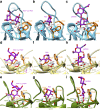Evolutionary relationships and expression analysis of EUL domain proteins in rice (Oryza sativa)
- PMID: 28560587
- PMCID: PMC5449364
- DOI: 10.1186/s12284-017-0164-3
Evolutionary relationships and expression analysis of EUL domain proteins in rice (Oryza sativa)
Abstract
Background: Lectins, defined as 'Proteins that can recognize and bind specific carbohydrate structures', are widespread among all kingdoms of life and play an important role in various biological processes in the cell. Most plant lectins are involved in stress signaling and/or defense. The family of Euonymus-related lectins (EULs) represents a group of stress-related lectins composed of one or two EUL domains. The latter protein domain is unique in that it is ubiquitous in land plants, suggesting an important role for these proteins.
Results: Despite the availability of multiple completely sequenced rice genomes, little is known on the occurrence of lectins in rice. We identified 329 putative lectin genes in the genome of Oryza sativa subsp. japonica belonging to nine out of 12 plant lectin families. In this paper, an in-depth molecular characterization of the EUL family of rice was performed. In addition, analyses of the promoter sequences and investigation of the transcript levels for these EUL genes enabled retrieval of important information related to the function and stress responsiveness of these lectins. Finally, a comparative analysis between rice cultivars and several monocot and dicot species revealed a high degree of sequence conservation within the EUL domain as well as in the domain organization of these lectins.
Conclusions: The presence of EULs throughout the plant kingdom and the high degree of sequence conservation in the EUL domain suggest that these proteins serve an important function in the plant cell. Analysis of the promoter region of the rice EUL genes revealed a diversity of stress responsive elements. Furthermore analysis of the expression profiles of the EUL genes confirmed that they are differentially regulated in response to several types of stress. These data suggest a potential role for the EULs in plant stress signaling and defense.
Keywords: Carbohydrate; Domain architecture; EUL; Lectin; Phylogeny; Rice.
Figures








Similar articles
-
OsEUL Lectin Gene Expression in Rice: Stress Regulation, Subcellular Localization and Tissue Specificity.Front Plant Sci. 2020 Mar 2;11:185. doi: 10.3389/fpls.2020.00185. eCollection 2020. Front Plant Sci. 2020. PMID: 32194594 Free PMC article.
-
Transcriptional behavior of EUL-related rice lectins toward important abiotic and biotic stresses.J Plant Physiol. 2014 Jul 15;171(12):986-92. doi: 10.1016/j.jplph.2014.04.004. Epub 2014 Apr 21. J Plant Physiol. 2014. PMID: 24974324
-
Proteins with an Euonymus lectin-like domain are ubiquitous in Embryophyta.BMC Plant Biol. 2009 Nov 23;9:136. doi: 10.1186/1471-2229-9-136. BMC Plant Biol. 2009. PMID: 19930663 Free PMC article.
-
An Update on Jacalin-Like Lectins and Their Role in Plant Defense.Int J Mol Sci. 2017 Jul 22;18(7):1592. doi: 10.3390/ijms18071592. Int J Mol Sci. 2017. PMID: 28737678 Free PMC article. Review.
-
Plant lectins and their many roles: Carbohydrate-binding and beyond.J Plant Physiol. 2021 Nov;266:153531. doi: 10.1016/j.jplph.2021.153531. Epub 2021 Sep 21. J Plant Physiol. 2021. PMID: 34601337 Review.
Cited by
-
De novo transcriptome analysis and comparative expression profiling of genes associated with the taste-modifying protein neoculin in Curculigo latifolia and Curculigo capitulata fruits.BMC Genomics. 2021 May 13;22(1):347. doi: 10.1186/s12864-021-07674-3. BMC Genomics. 2021. PMID: 33985426 Free PMC article.
-
CROWN ROOTLESS1 binds DNA with a relaxed specificity and activates OsROP and OsbHLH044 genes involved in crown root formation in rice.Plant J. 2022 Jul;111(2):546-566. doi: 10.1111/tpj.15838. Epub 2022 Jul 9. Plant J. 2022. PMID: 35596715 Free PMC article.
-
OsEUL Lectin Gene Expression in Rice: Stress Regulation, Subcellular Localization and Tissue Specificity.Front Plant Sci. 2020 Mar 2;11:185. doi: 10.3389/fpls.2020.00185. eCollection 2020. Front Plant Sci. 2020. PMID: 32194594 Free PMC article.
-
Messages From the Past: New Insights in Plant Lectin Evolution.Front Plant Sci. 2019 Jan 29;10:36. doi: 10.3389/fpls.2019.00036. eCollection 2019. Front Plant Sci. 2019. PMID: 30761173 Free PMC article.
-
130 years of Plant Lectin Research.Glycoconj J. 2020 Oct;37(5):533-551. doi: 10.1007/s10719-020-09942-y. Epub 2020 Aug 29. Glycoconj J. 2020. PMID: 32860551 Free PMC article. Review.
References
-
- Al Atalah B, Fouquaert E, Van Damme EJM. Promoter analysis for three types of EUL-related rice lectins in transgenic Arabidopsis. Plant Mol Biol Rep. 2013;31:1315–1324. doi: 10.1007/s11105-013-0611-2. - DOI
-
- Al Atalah B, De Vleesschauwer D, Xu J, Fouquaert E, Höfte M, Van Damme EJM (2014a) Transcriptional behavior of EUL-related rice lectins toward important abiotic and biotic stresses. J Plant Physiol 171:986-992 - PubMed
LinkOut - more resources
Full Text Sources
Other Literature Sources

